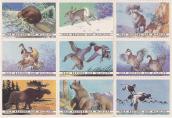Bellinghausen & The Ransom of NWF
When I was a young man, I had the pleasure of meeting some of the great seal collectors of a generation now past. Charles Bellinghausen was one of them. I first met him with my dad, John Denune, Sr. at Ray Mosbaugh's home in Joplin, MO. Bellinghausen came down from Wichita to be there. A year of so later dad and I made the trek to Bellinghausen's home in Wichita. Charles had a large collection and inventory of US and worldwide TB seals as well as other funds, and a fabulous collection of Catholic seals and was the primary author of the Catholic section of the All Fund Catalog.
Crime is nothing new in America, and stamp collectors can be targets of it. In 1969 when Ohio Governor Jim Rhodes, of Kent State fame, commuted the life sentence of notorious gangster Yonnie Licavoli, he joined the Columbus Philatelic Club. A subject of "Gang Busters" radio show of the 1930's Licavoli engaged in a war with a rival gang in Toledo, and was convicted of conspiracy to murder in 1934. Though he served his time, no one knows if Yonnie and his men were involved in a string of stamp burglaries, but afterward, the CPC quit publishing its membership list.
Charles Bellinghausen was the victim of a seal burglary. Most criminals make mistakes, like going thru a window when the back door is unlocked. Faced with Charles house full of seals, they had no idea what to steal. One item taken from the home was a carton of National Wildlife Federation seals. NWF seals were first issued in 1938 to promote wildlife conservation and to raise funds for charity. NWF sheets contain many varieties of large colorful seals and were designed by leading artists. One of 17 different designs issued in 1938 was by J. N. "Ding" Darling, an editorial cartoonist and conservation activist. Darling had previously used this design on the first US duck stamp in 1934, and his design also appeared in 1984 on a US postage stamp commemorating the 50th anniversary of the Waterfowl Preservation Act.
So, after the thief attempted to sell the stolen carton of NWF to every stamp dealer in the area, they contacted Charles, and asked him what he would pay to get them back. Charles, not a man given to offensive language, had a few choice words, which included, "You can keep them, I don't want them.". Unable to cash in their ill gotten gain, and knowing the carton could incriminate them, the "not so smart" thief was in a dilemma. Charles reported that the lost carton mysteriously re-appeared on his front step, which eventually became part of dad's inventory of NWF seals.
